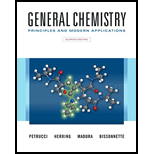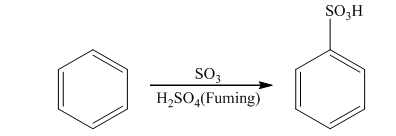
General Chemistry: Principles And Modern Applications Plus Mastering Chemistry With Pearson Etext -- Access Card Package (11th Edition)
11th Edition
ISBN: 9780134097329
Author: Ralph H. Petrucci, F. Geoffrey Herring, Jeffry D. Madura, Carey Bissonnette
Publisher: PEARSON
expand_more
expand_more
format_list_bulleted
Question
Chapter 27, Problem 38E
Interpretation Introduction
Interpretation:
A balanced chemical equations for elementary processes involved in the formation of benzenesulfonic acid from reaction of tertiary benzene and sulfuric acid should be written.
Concept introduction:
Sulphonation is a electrophilic substitution reaction in which benzene reacts with sulfur trioxide and fuming sulfuric acid to product benzenesulfonic as a final product.

Expert Solution & Answer
Want to see the full answer?
Check out a sample textbook solution
Students have asked these similar questions
CH3
CH3
Br-
Br2
CH2CI2
CH3
CH3
H3C
H3C
Br
Electrophilic addition of bromine, Br2, to alkenes yields a 1,2-dibromoalkane. The reaction proceeds through a cyclic intermediate known as a
bromonium ion. The reaction occurs in an anhydrous solvent such as CH2C12.
In the second step of the reaction, bromide is the nucleophile and attacks at one of the carbons of the bromonium ion to yield the product. Due to
steric clashes, the bromide ion always attacks the carbon from the opposite face of the bromonium ion so that a product with anti stereochemistry
is formed.
Draw curved arrows to show the movement of electrons in this step of the mechanism.
Arrow-pushing Instructions
CH3
CH3
Br-
.CH3
.CH3
H3C
H3C
:Br
:Br:
When the alkyl bromides (listed here) were subjected to hydrolysis in a mixture of ethanol and water (80% EtOH/20% H20) at 55°C, the rates of the reaction showed the
following order:
(CH3)3CB > CH3B > CH3CH2Br > (CH3)2CHBR
Provide an explanation for this order of reactivity.
Two different mechanisms are involved. (CH3)3CBr reacts by an
* mechanism and apparently this reaction takes place faster. The other three alkyl halides react by
* mechanism, and their reactions are slower because the
3. The reaction rates of CH3BR, CH3CH2Br, (CH3)2CHBR are affected by
an
* and thus their order of reactivity is CH3B > CH3CH2B > (CH3)2CHBR.
When the alkyl bromides (listed here) were subjected to hydrolysis in a mixture of
ethanol and water (80% EtOH/20% H2O) at 55 °C, the rates of the reaction showed the
following order:
(CH3)3CBR > CH3Br > CH3CH2Br > (CH3)2CHBR
Provide an explanation for this order of reactivity.
Chapter 27 Solutions
General Chemistry: Principles And Modern Applications Plus Mastering Chemistry With Pearson Etext -- Access Card Package (11th Edition)
Ch. 27 - Describe what is meant by each of the following...Ch. 27 - Prob. 2ECh. 27 - Prob. 3ECh. 27 - Prob. 4ECh. 27 - Prob. 5ECh. 27 - Prob. 6ECh. 27 - Prob. 7ECh. 27 - Prob. 8ECh. 27 - Answer the following questions for this SN2...Ch. 27 - Answer the following questions for this SN1...
Ch. 27 - Substitution and Elimination Reactions Answer the...Ch. 27 - Prob. 12ECh. 27 - Prob. 13ECh. 27 - Prob. 14ECh. 27 - Prob. 15ECh. 27 - Substitution and Elimination Reactions Molecule...Ch. 27 - Prob. 17ECh. 27 - Prob. 18ECh. 27 - Prob. 19ECh. 27 - Prob. 20ECh. 27 - Prob. 21ECh. 27 - Prob. 22ECh. 27 - Prob. 23ECh. 27 - Substitution and Elimination Reactions (R) — 2 —...Ch. 27 - Prob. 25ECh. 27 - Prob. 26ECh. 27 - Prob. 27ECh. 27 - Prob. 28ECh. 27 - Prob. 29ECh. 27 - Alcohols and Alkenes Predict the product(s) of the...Ch. 27 - Prob. 31ECh. 27 - Alcohols and Alkenes Give the structure of the...Ch. 27 - Alcohols and Alkenes Give the major product that...Ch. 27 - Prob. 34ECh. 27 - Prob. 35ECh. 27 - Prob. 36ECh. 27 - Prob. 37ECh. 27 - Prob. 38ECh. 27 - Prob. 39ECh. 27 - Prob. 40ECh. 27 - Prob. 41ECh. 27 - Prob. 42ECh. 27 - Reactions of Alkanes (a) Write the initiation,...Ch. 27 - Reactions of Alkanes Write the initiation,...Ch. 27 - Prob. 45ECh. 27 - Polymerization Reactions Explain why Dacron is...Ch. 27 - Prob. 47ECh. 27 - Prob. 48ECh. 27 - Prob. 49ECh. 27 - Prob. 50ECh. 27 - Prob. 51ECh. 27 - Prob. 52ECh. 27 - Prob. 53ECh. 27 - Prob. 54ECh. 27 - Prob. 55IAECh. 27 - Prob. 56IAECh. 27 - Prob. 57IAECh. 27 - Prob. 58IAECh. 27 - Prob. 59IAECh. 27 - Prob. 60IAECh. 27 - Prob. 61IAECh. 27 - Prob. 62IAECh. 27 - Prob. 63IAECh. 27 - Prob. 64IAECh. 27 - Prob. 65IAECh. 27 - Prob. 66IAECh. 27 - Prob. 67IAECh. 27 - Prob. 68IAECh. 27 - Prob. 69IAECh. 27 - Prob. 70IAECh. 27 - Prob. 71IAECh. 27 - Prob. 72IAECh. 27 - Prob. 73IAECh. 27 - Prob. 74IAECh. 27 - Prob. 75IAECh. 27 - Prob. 76IAECh. 27 - Prob. 77IAECh. 27 - The reduction of aldehydes and ketones with a...Ch. 27 - Explain the important distinctions between each...Ch. 27 - Prob. 80SAECh. 27 - Prob. 81SAECh. 27 - Prob. 82SAECh. 27 - Prob. 83SAECh. 27 - Prob. 84SAECh. 27 - What is the major organic product obtained in the...Ch. 27 - Prob. 86SAE
Knowledge Booster
Similar questions
- Following is an equation for iodination of toluene. This reaction does not take place. All that happens under experimental conditions for the formation of radicals is initiation to form iodine radicals, I , followed by termination to reform I2. How do you account for these observations?arrow_forwardH9.26 - Level 1 := Unanswered • 3 attempts left Compound A can be converted into compound E when treated with concentrated H2SO4. This reaction mechanism proceeds via three intermediates (compounds B-D). Sort the intermediates in the correct order according to the reaction mechanism. Compound C Compound B Compound D Your answer OH compound A compound E intermediates OH2 B Darrow_forwardShort Answer Problem 4 Homework What is the identity of A? Predict the products B and C from the ozonolysis reactions depicted. Short4.png ! (63KB)arrow_forward
- 196. Subject : - Chemistryarrow_forwardComplete the following reaction with explanationarrow_forwardH3C CH3 H3C NA C→XT Br Br₂ CH₂Cl₂ H3C Electrophilic addition of bromine, Br₂, to alkenes yields a 1,2-dibromoalkane. The reaction proceeds through a cyclic intermediate known as a bromonium ion. The reaction occurs in an anhydrous solvent such as CH₂Cl₂. CH3 Br In the second step of the reaction, bromide is the nucleophile and attacks at one of the carbons of the bromonium ion to yield the product. Due to steric clashes, the bromide ion always attacks the carbon from the opposite face of the bromonium ion so that a product with anti stereochemistry is formed. Draw curved arrows to show the movement of electrons in this step of the mechanism. Arrow-pushing Instructions Br CH3 H3C CH3arrow_forward
- i cant find the answersarrow_forwardCompound D, shown below, reacts with hydrogen bromide by electrophilic addition. A mixture of two organic compounds, E and F, is formed. CH3 CH₂CH₂ CH3 H compound D HBr Mixture of organic compounds E and F (i) Name the the two organic compounds E and F and show their condensed formula. (ii) Briefly explain the mechanism of the reaction between compound D and hydrogen bromide to form either compound E or compound F. (You can list/state the main steps) (iii) Which compound, E or F is the major product?arrow_forwardCH3 CH3 Br- Br2 .CH3 CH2Cl2 CH3 H3C H3C Br Electrophilic addition of bromine, Brɔ, to alkenes yields a 1,2-dibromoalkane. The reaction proceeds through a cyclic intermediate known as a bromonium ion. The reaction occurs in an anhydrous solvent such as CH,Cl,. In the second step of the reaction, bromide is the nucleophile and attacks at one of the carbons of the bromonium ion to yield the product. Due to steric clashes, the bromide ion always attacks the carbon from the opposite face of the bromonium ion so that a product with anti stereochemistry is formed. Draw curved arrows to show the movement of electrons in this step of the mechanism. Arrow-pushing Instructions CH3 CH3 CH3 CH3 H3C H3C :Br: :Br:arrow_forward
- H Br Br2 CH2Cl2 H, Br Electrophilic addition of bromine, Brɔ, to alkenes yields a 1,2-dibromoalkane. The reaction proceeds through a cyclic intermediate known as a bromonium ion. The reaction occurs in an anhydrous solvent such as CH2Clɔ. In the second step of the reaction, bromide is the nucleophile and attacks at one of the carbons of the bromonium ion to yield the product. Due to steric clashes, the bromide ion always attacks the carbon from the opposite face of the bromonium ion so that a product with anti stereochemistry is formed. Draw curved arrows to show the movement of electrons in this step of the mechanism. Arrow-pushing Instructions H Br H- Br H. :Br: Proviouc Noxtarrow_forward-OH H2O what is the mechanism for the reaction with the productarrow_forwardQ11arrow_forward
arrow_back_ios
SEE MORE QUESTIONS
arrow_forward_ios
Recommended textbooks for you
 Organic ChemistryChemistryISBN:9781305580350Author:William H. Brown, Brent L. Iverson, Eric Anslyn, Christopher S. FootePublisher:Cengage Learning
Organic ChemistryChemistryISBN:9781305580350Author:William H. Brown, Brent L. Iverson, Eric Anslyn, Christopher S. FootePublisher:Cengage Learning Chemistry by OpenStax (2015-05-04)ChemistryISBN:9781938168390Author:Klaus Theopold, Richard H Langley, Paul Flowers, William R. Robinson, Mark BlaserPublisher:OpenStax
Chemistry by OpenStax (2015-05-04)ChemistryISBN:9781938168390Author:Klaus Theopold, Richard H Langley, Paul Flowers, William R. Robinson, Mark BlaserPublisher:OpenStax

 EBK A SMALL SCALE APPROACH TO ORGANIC LChemistryISBN:9781305446021Author:LampmanPublisher:CENGAGE LEARNING - CONSIGNMENT
EBK A SMALL SCALE APPROACH TO ORGANIC LChemistryISBN:9781305446021Author:LampmanPublisher:CENGAGE LEARNING - CONSIGNMENT

Organic Chemistry
Chemistry
ISBN:9781305580350
Author:William H. Brown, Brent L. Iverson, Eric Anslyn, Christopher S. Foote
Publisher:Cengage Learning

Chemistry by OpenStax (2015-05-04)
Chemistry
ISBN:9781938168390
Author:Klaus Theopold, Richard H Langley, Paul Flowers, William R. Robinson, Mark Blaser
Publisher:OpenStax



EBK A SMALL SCALE APPROACH TO ORGANIC L
Chemistry
ISBN:9781305446021
Author:Lampman
Publisher:CENGAGE LEARNING - CONSIGNMENT